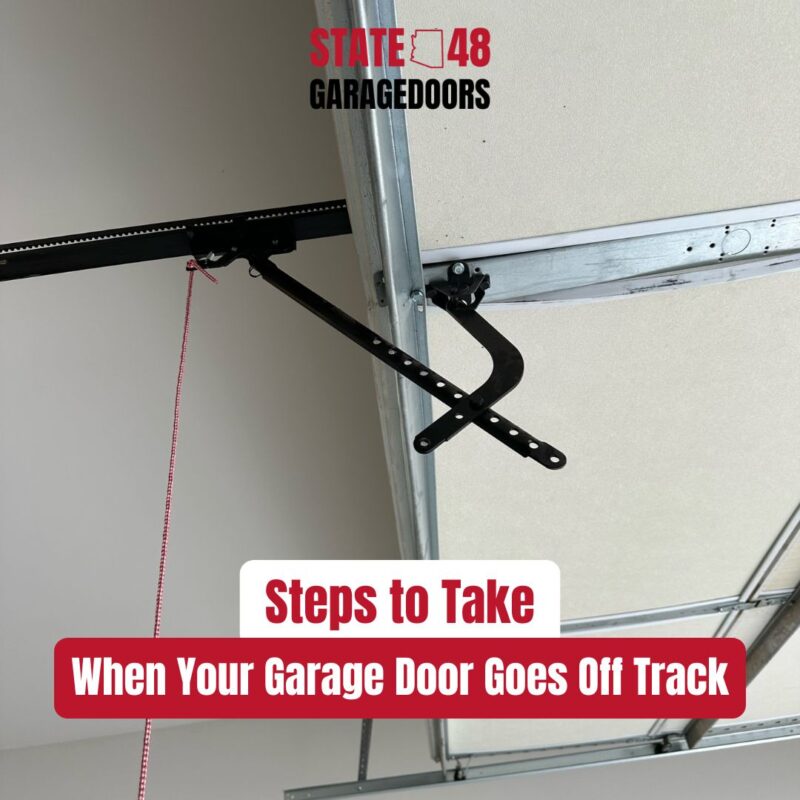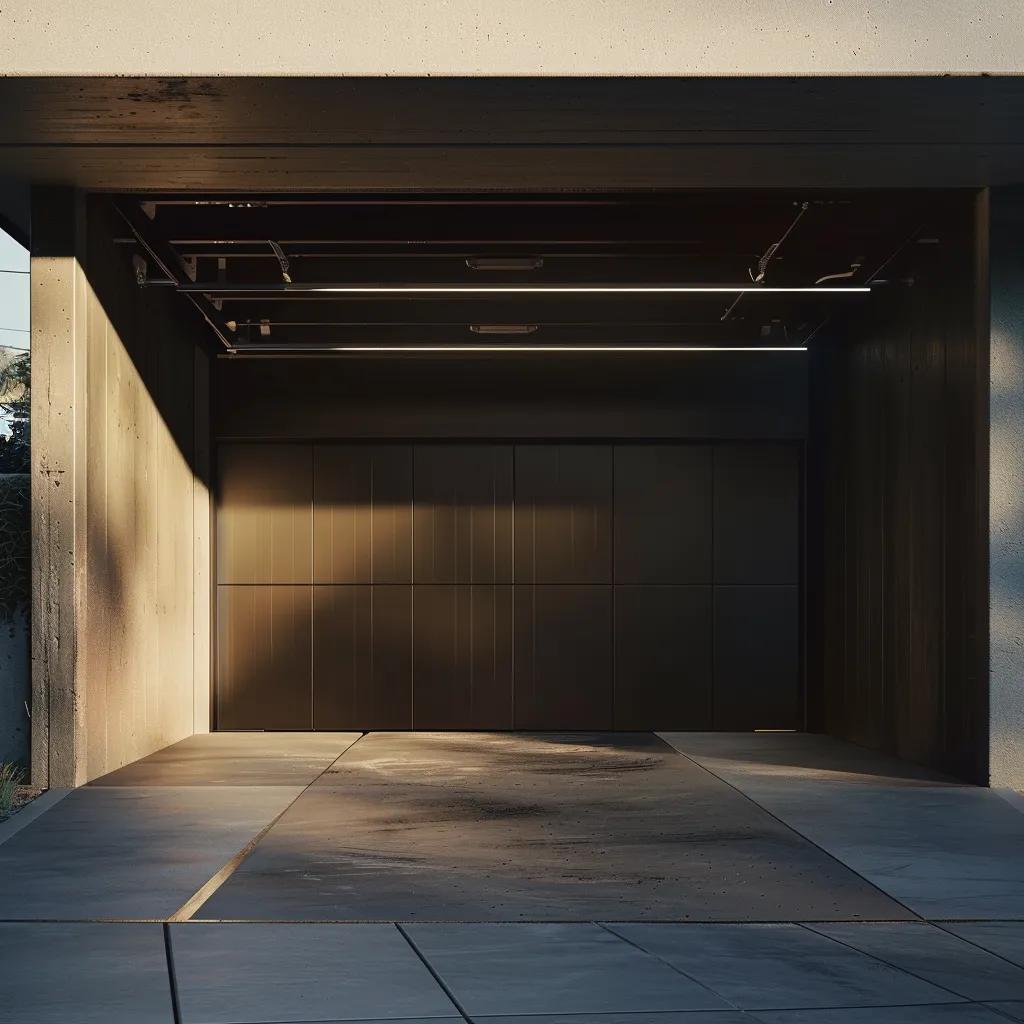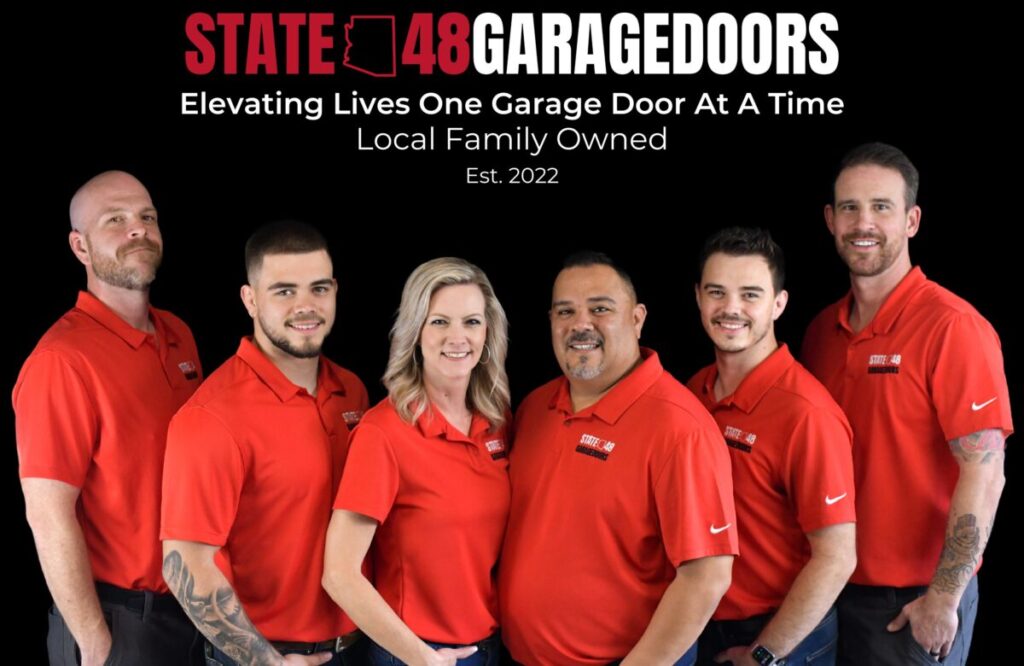
What to Do if Your GarageDoor Is Off Track
When your garage door goes off track, it can be both dangerous and frustrating. As a homeowner in the Phoenix metro area, you want to be sure every part of your home is working correctly—especially something as heavy and complex as your garage door. Off-track doors cause friction between steel rollers and nylon hinge parts, leading to excessive wear and tear. They can also create hazardous situations involving torsion springs and lift cables. This not only damages the door opener and mechanical parts but also puts you and your family at risk.
In this article, you’ll learn what to do immediately if your garage door goes off track and how to spot the warning signs. We explain why professional garage door repair in Phoenix is essential. From safety precautions and initial troubleshooting to detailed diagnostics and maintenance tips, we cover it all. You’ll understand how vibration, rust, corrosion, and debris contribute to wear and how a certified technician addresses these issues. Read on to learn how experts restore your garage door and opener to safe, reliable operation.

Prioritize Safety When Your GarageDoor Is Off Track
When you discover that your garagedoor is off track, your first priority is ensuring everyone’s safety. Immediately cease operating the door, as further motion could worsen the problem or even result in injury. Often, off-track doors create dangerous gaps and expose moving parts like rollers, cables, and the garagedoor opener mechanism. This increase in exposure can lead to accidents or injuries, especially if you’re handling repair work yourself and expose yourself to hazards like friction-generated heat or sharp edges on steel brackets.

Immediately Cease Door Operation
Immediately stop any movement of the door. The very first action is to unplug your garagedoor opener, ensuring the door cannot move unexpectedly and cause harm. With the power cut, you eliminate the risk associated with further mechanical strain, vibration, or tension on the torsion spring and belt systems. This also prevents any additional wear and tear that might result from an attempt to operate a door that is misaligned or off track.
Disengage the Automatic GarageDoor Opener
As soon as you stop the door, remove the remote control power source by disconnecting the automatic opener. This step is critical because any residual signals could inadvertently cause movement, potentially resulting in further misalignment or mechanical damage. The opener’s motor and system, which are subject to wear from friction and tension, could exacerbate the situation if they continue to be energized. In the Phoenixclimate, where heat and dust combine, proper disconnection will also prevent electrical issues due to debris or corrosion around electronic components.
Clear the Area Around the GarageDoor
Before you or any service technician begins to assess the situation, ensure that all persons and vehicles are at a safe distance. Remove any objects, tools, or materials—like woodworking items or plumbing tools that might be nearby—that could accidentally fall or cause tripping hazards. For safety and ease of repair, it is best to have a clear area to work with. This clearing also protects curious children or pets who might get too close to a misaligned door, where vibrations and moving parts (like bearings and wheels) can become dangerous.
Secure the Door to Prevent Further Movement if Possible
If you are able to safely secure the door in its current off-track position, do so. Use a strong brace, a wooden wedge, or heavy-duty rope to prevent the door from moving. Securing the door minimizes further damage by reducing vibration against damaged components such as worn rollers and misaligned tracks. It also supports the overall structure of the door until a professional repair technician can safely intervene. In areas like the Phoenix metropolitan region, where rapid temperature changes can increase the risk of component failure, securing your door immediately is an important step in maintaining home safety.
Identifying the Signs of a GarageDoor Off Track Problem
Early detection of an off-track garagedoor can save you from heavy repair costs and potential injury. By observing precise indicators, you are better positioned to call for help before your door suffers additional damage. When a garagedoor is misaligned, you might notice visible gaps or unusual spacing between the rollers and tracks. This misalignment exhibits itself as an uneven door position, significant misplacement compared to its frame, or difficulty in manually moving the door—which could indicate a clear mechanical malfunction.
Look for Gaps Between Rollers and Tracks
If you inspect the door closely, you might see abnormal spacing between the rollers and the tracks. In an ideal condition, rollers made of steel or nylon should fit snugly into the track system with minimal gaps. Excessive gaps often indicate that the door has shifted or been impacted by debris, wear, or accidental impact from a high-tension object. For instance, a stray piece of stone or even heavy debris might have caused a sudden force high enough to dislodge the mechanism from its proper alignment. This observation is crucial as it signals underlying problems such as issues with the bracket, bearing, or even problems with the installation by the overhead door company.
Observe Uneven or Crooked Door Positioning
One prominent sign is the uneven or crooked appearance of the door. When your garagedoor is off track, it will not hang level and will appear tilted, which can be especially noticeable if you compare both sides. Such a misalignment can be due to worn-out rollers, significant wear and tear, or even an impact with a car or tool. A door that doesn’t match its corresponding window and frame indicates tension imbalances, possibly arising from the torsion spring losing its strength due to years of constant usage under pressure. Recognizing the uneven positioning early means you can ensure the door is not forced into further motion, thus avoiding additional damage or costly repairs.
Notice Difficulty in Manual Door Movement
A well-balanced garagedoor should move smoothly when operated by hand. However, if the door becomes difficult to open or close manually, that could be a clear indicator of an off-track problem. You may experience sudden stops, resistance, or even jerky movements when you try to slide the door. This difficulty is often due to misaligned vertical tracks or even issues with lift cables that have become detached or frayed. Continued manual force, especially in environments where the mechanical parts are already suffering from vibration-induced wear and tear, may lead to further damage. In the Phoenix area, where climate conditions may also cause components like wood or steel to expand or contract, careful manual inspection is significant for early diagnosis.
Check for Damaged Rollers or Bent Tracks
Lastly, inspect the rollers and tracks for any signs of damage. Look for bent tracks, damaged rollers, or evidence of wear such as scratches and corrosion. Rollers, particularly those made from nylon or steel, must roll effortlessly along precise tracks. Evidence of wear such as chipped edges or discoloration due to grease and friction indicates that the door’s mechanism has undergone significant strain. Additionally, bent tracks may result from accidental impacts or natural wear from many cycles over time. In many cases, these issues can be compounded by elements like debris and paint buildup. Early detection of such issues increases the chances of a successful repair without a complete replacement.
Common Reasons Your GarageDoor Came Off Its Tracks
Understanding the root cause is essential to ensure a lasting repair. There are several common reasons why your garagedoor might have come off its tracks. Often, a combination of factors like accidental impact, general wear and tear, and issues with key components can converge to cause misalignment. For homeowners in the Phoenix metropolitan area, where environmental conditions and climate stress can accelerate component degradation, knowing these reasons is particularly important.
Accidental Impact From Vehicles or Objects
One of the primary reasons a garage door may come off track is accidental impact. Whether it’s a car bumping into the door due to a misaligned parking maneuver or a heavy object falling onto the door, such impacts create a force that can shift the alignment of your door. In addition to the immediate misalignment, repeated impacts over time can compound the friction and stress on components like the torsion spring and the lift mechanism. Even a single, significant impact can cause the rollers or the vertical tracks to bend, particularly if the door is already subject to wear from regular use. Reliable customer service and prompt repair by a professional garagedoor repair phoenix technician are recommended to fix the underlying issues promptly.
Worn Out or Broken Rollers
Over time, rollers face substantial wear and tear due to constant friction and movement. When they become worn out or even break, they cannot maintain the proper alignment of the door. In Phoenix’s heat, where grease can deteriorate and parts can corrode, the regular maintenance of rollers becomes even more vital. Worn rollers may suddenly slip or fail to grip the tracks, causing your door to shift unexpectedly. Moreover, a broken roller may create uneven tension along the door, contributing further to misalignment and increasing the risk of an accident. It is important to periodically inspect these rollers and address any signs of degradation immediately.
Damaged or Misaligned Vertical Tracks
The vertical tracks serve as the guide rails that keep your garagedoor aligned. Over time or due to unforeseen impacts, these tracks can become bent or misaligned. When this happens, the door will likely come off track and not operate smoothly. Exposure to the elements, such as rain, dirt, and dust in a desertclimate like Phoenix’s, further accelerates this damage. Damaged or misaligned tracks not only cause operational issues but also create additional vibration and stress on the door’s other components. A careful inspection of these tracks can reveal dents, bends, or even rust formations that indicate a need for professional intervention.
Issues With Lift Cables Snapping or Loosening
The lift cables play a crucial role in both the operation and safety of your garagedoor. If these cables are loose, frayed, or snap completely, the door’s balance will be severely affected. Even minor fraying can compromise the cable’s ability to hold the door in place, resulting in an off-track situation. In addition to the tension and wear and tear that strains these cables, environmental factors like the Phoenixdesertclimate can also contribute if the cables are not properly maintained. Over time, this wear, coupled with a lack of regular lubrication and inspection, can lead to cable failure. When this risk is identified early, you can prevent further damage by ensuring professional replacement and repair.
Steps for Assessing the GarageDoor Off Track Situation
Once safety is prioritized and the immediate risks are controlled, you need to assess the situation to determine the next steps for repair. It is crucial to examine the extent of the damage to decide whether you can attempt a minor adjustment or if professional help is required immediately. Proper assessment includes checking not only for obvious misalignment but also for any underlying component issues like damaged rollers, frayed cables, or bent tracks. A detailed assessment minimizes the risk of exacerbating the problem, especially when working with sensitive mechanisms such as springs and sensors that require a wrench, proper customer service, and precise inspection methods.
Examine the Extent of Track Damage
Start by closely examining the vertical and horizontal tracks for any visible warping, dents, or bends. Look for signs of rust or corrosion that might indicate long-term wear influenced by climate factors like desert heat and dust. Track damage is the most obvious indicator that your garagedoor is off track, and even slight misalignments can create significant friction and vibration when the door moves. Inspecting the entire track system, from the top to the bottom, will help you determine whether the damage is localized or widespread. In many cases, a misalignment might be fixed with a small adjustment, but severe bending or damage in multiple sections generally requires professional repair.
Inspect Rollers for Wear or Breakage
Next, observe the rollers that run along the tracks. These components are critical in maintaining smooth, friction-free motion. Check each roller for any signs of wear, such as chipped edges, uneven surfaces, or complete breakage. Even if the track appears relatively intact, damaged rollers can cause the door to drift out of alignment. Rollers in a well-maintained system are typically made of durable steel or quality nylon, but constant use and exposure to elements like grease and dirt can lead to a significant reduction in their performance. If even one roller is not functioning properly, it can affect the tension distribution along the door, subsequently leading to additional strain on cables and springs.
Check Cables for Fraying or Detachment
After examining the physical tracks and rollers, move on to the lift cables. These cables are vital for counterbalancing the door‘s weight during operation. Look for any signs of fraying, which might indicate that the cables are nearing the end of their service life. Also check for proper attachment points—cables that have come loose or detached from their anchors will compromise the entire door system. The cables need to maintain the correct tension to support the door evenly. In the harsh climate of Phoenix, where wear and tear are common due to elevated temperatures and particulate matter like dust, periodic cable inspections are essential. Any issues with the cables should be addressed promptly to prevent sudden failure and potential injury.
Determine if Tracks Are Merely Misaligned or Bent
Finally, assess whether the issue with your garagedoor is a simple misalignment or if you’re dealing with genuinely bent tracks that require repair. In many instances, tracks may only appear off due to minor shifts that can be re-aligned with the proper tools, such as a wrench designed for garagedoor components. However, if the tracks show signs of permanent bending or severe damage, a recalibration through professional garagedoor repair in phoenix is necessary. Understanding the difference between misalignment and extensive structural damage prevents unnecessary DIY attempts that could worsen the condition. Remember, improper handling might exacerbate friction, wear, and even cause damage to critical parts like the torsion spring and associated mechanisms.
Seeking Professional GarageDoor Repair Services
Determining when to call a professional is key to safely resolving an off-track garagedoor.
While simple misalignments might tempt you to use a wrench or attempt a DIY fix, forcing a derailed door carries clear risks. Many parts of your garage door, from sensors to heavy components like torsion springs and lift cables, are under significant tension. Trying to repair it without experience can worsen the problem and jeopardize safety. Knowing when expert help is needed is key to a lasting fix.
Recognizing When DIY Garage Door Repair Is Unsafe
Before you try any repairs, assess the risks. If you spot multiple issues—bent tracks, damaged rollers, or frayed cables—don’t try to realign everything yourself. Garage door repair involves complex electrical and mechanical systems. For example, if your door’s off-track condition is caused by heavy wear or impact, DIY fixes could lead to more damage or injury. In harsh climates like Phoenix’s desert, dust buildup, moisture damage to springs, and worn bearings add extra stress. Professionals have the right tools and expertise to safely fix these problems.
The Dangers of Forcing a Derailed Door
Forcing a door after it goes off track can cause serious damage. Extra force can increase vibration, damaging belts, brushes, or the motorized opener. This might lead to costly repairs, warranty issues, or even full component replacements. Phoenix’s high temperatures already strain parts, so a rushed DIY repair can turn a simple fix into a major expense involving springs, cables, or door panels.
Locating Reputable Garage Door Repair Technicians
Once you decide to seek professional help, find technicians experienced with these issues. Look for overhead door companies in Phoenix with BBB accreditation and positive reviews. Choose specialists in off-track door repairs who understand local wear and tension problems. Reliable providers offer free inspections, detailed quotes, and warranties. Because garage door systems combine mechanical and electrical parts, hiring certified pros ensures repairs meet safety and manufacturer standards.
Understanding the Garage Door Repair Process for Off-Track Doors
Repairs start with a detailed inspection by a certified technician. They’ll manually operate the door, check steel wheels, nylon rollers, and track alignment, then diagnose problems. Repairs might include realigning or replacing tracks, adjusting cable tension, or swapping worn rollers. Techs also apply high-grade lubricant to reduce friction and wear. A good repair addresses the issue and often includes homeowner training on maintenance and prevention. This helps avoid future problems and extends your door’s lifespan.
Implementing GarageDoorMaintenance to Prevent Future Issues
Preventative maintenance is critical for ensuring long-term performance and safety of your garagedoor. Regular upkeep can help mitigate common issues like friction, wear, and misalignment in the Phoenix metropolitan area. By following a maintenance schedule, you can significantly reduce the risk of costly repairs or even dangerous failures.
This section reviews key steps to maintain a properly functioning garage door system. From routine cleaning to professional inspections, these actions help minimize wear and tear. Whether it’s periodic lubrication or inspecting parts like the torsion spring, diligent care is essential.
Routine Cleaning and Inspection of Tracks
Keeping the tracks clean is the first step in maintenance. Debris, dust, and grease can build up over time, increasing friction on the rollers. Use gentle cleaners and a soft brush to clear buildup from the tracks. Regular inspections should check for corrosion or damage caused by weather, such as rust, paint chipping, or dents. In Phoenix’s desert climate, sand and dirt can get into tight spaces and cause extra wear. Cleaning the tracks thoroughly once a month, combined with a full inspection, helps catch problems early. This reduces vibration and lowers the risk of the door coming off the track.
Lubrication Schedule for Rollers and Moving Parts
Applying grease or lubricant to moving parts like rollers, hinges, and lift cables is necessary for smooth operation. Lubrication cuts friction and prevents early wear on steel, nylon, and other materials. Use a high-quality lubricant made for garage doors to reduce noise and improve performance. During your monthly maintenance, pick a lubricant that withstands high heat and dust. This routine prevents vibration and misalignment—common causes of an off-track door. Proper lubrication also extends the life of parts like torsion springs and helps your door opener work efficiently, avoiding emergency repairs.
Regular Checks for Component Wear and Tear
In addition to cleaning and lubrication, scheduling a detailed inspection for worn-out parts is critical for preventing future problems. Look for signs of wear on each component—such as frayed lift cables, worn rollers, and loose hinges.
Over time, components like gutter brackets or support beams can degrade, especially where metal meets wood or nylon. Using a systematic checklist during inspections helps identify issues before they become safety hazards. If you notice a small issue, such as a frayed cable or a misaligned roller, act immediately to fix it. Regular maintenance checks reduce unexpected failures. This is crucial in regions with extreme climates like Phoenix, where sun exposure and desert winds speed up wear.
Benefits of Annual Professional Garage Door Maintenance
Routine DIY maintenance helps, but an annual professional inspection ensures no hidden problems are missed. Professionals use specialized tools to assess not just surface conditions but also the operational health of your garage door parts. They check spring tension, sensor performance, and door opener function. Annual maintenance detects issues you might overlook. This prevents friction, wear, and costly repairs. It also improves durability and efficiency. You gain peace of mind knowing hazards like misalignment, sensor failure, or corrosion are handled promptly.
Frequently Asked Questions
Q: What immediate steps should I take when my garagedoorgoes off track? A: Immediately stop operating the door, unplug the automatic opener, and secure the door with a brace. This prevents additional damage and reduces safety risks until a professional technician can assess the damage.
Q: How can I tell if the problem is caused by misaligned tracks or damaged rollers? A: Look for visible gaps between the rollers and tracks and uneven door positioning when manually operating it. Misalignment often results in uneven door movement, while damaged rollers may show signs of wear like chipping or breakage.
Q: Is it safe to attempt a DIY repair on an off-track garagedoor? A: It is generally not recommended. The interconnected system of cables, springs, and sensors can be hazardous if not handled properly. DIY repairs can worsen the issue, so professional garage door repair is advised.
Q: How often should I perform maintenancechecks on my garagedoorand its components? A: Regular monthly maintenance—including cleaning, lubrication, and inspection for wear—and an annual professional inspection are recommended to prevent issues such as off-track doors.
Q: Why does my garagedoorcome off track, and how can I prevent it? A: Common causes include accidental impact, worn rollers, misaligned tracks, and loose cables. Prevention involves routine maintenance, proper lubrication, and immediate professional intervention if any issues are detected.
Q: Can regular maintenanceprevent future off-track incidents? A: Yes. Regular cleaning, lubrication, and thorough inspections can significantly reduce friction, tension imbalances, and other issues that lead to a door coming off track, ultimately extending the life of your garage door system.
Q: How do environmental factors in Phoenixaffect my garagedoor? A: The desert climate in Phoenix, characterized by high temperatures, dust, and occasional moisture from weather changes, accelerates wear on your door’s components. This exposure increases the importance of regular cleaning, lubrication, and professional inspections to keep your garage door functioning properly.
Final Thoughts
Your garagedoor is a critical component of your home’s safety and convenience. By understanding the signs of an off-track door and taking immediate safety measures, you can prevent further damage and ensure that repairs are performed efficiently. Regular maintenance and professional inspections are the keys to prolonging your door’s life and preventing future issues. If you suspect a problem, don’t hesitate to book an appointment with a certified garagedoor technician in Phoenix for a safe and reliable inspection.
Before each repair, inspect each component to ensure that preventative maintenance measures are effectively reducing friction and wear, and consult professional services when necessary.
By following these detailed steps, you harness preventative measures to protect your investment. Ensuring every component is maintained properly prevents future disruptions and adds to the longevity of your garagedoor. With a regular care routine, you can avoid costly replacements and unexpected repairs.




